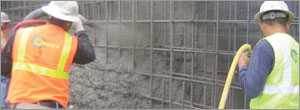| Briefly… |
|
|
|
|
|
|
|
|
|
|
| |
| Featured |
 |
| |
| Issues with waterproofing blind-side shotcrete foundation walls |
| |
| Below-grade construction with shotcrete is gaining popularity across the country. The trend of using shotcrete instead of the conventional cast-in-place (CIP) concrete can be attributed to the lower construction cost and time saved by not having to place and remove formwork. However, the use of shotcrete has resulted in a higher incidence of water ingress in below-grade foundations. |
| |
| » Read more |
| |
| Specifying the right framing connectors for deflection |
| |
| Cold-formed metal framing (CFMF) is one of the most widely used framing materials in commercial and residential construction because of its ability to provide strength and stability in a number of conditions. A well-detailed framing system can accommodate forces imposed on the structure by gravity, wind uplift, and seismic forces. When it comes to deflection, the performance of the connections between CFMF and the building structure is critically important, especially in coastal and high-seismic zones where structures face greater risk of movement, stress, and loading from natural events like earthquakes and high-velocity winds.
|
| |
| » Read more |
|
| |
|
| |
| Inside CSI |
 |
|
| |
| |
| GROW-THROUGH PAVING SECTION |
| Up to the latest MasterFormat, no section to properly place grow-through pavement. “Flexible” pavement still means asphalt (or rubber), and “rigid” means concrete. I have noticed the 2018 has many more provisions for things like recycling construction waste compared to 2016 (which I applaud), but still does not have an update for this more environmentally friendly alternative to paving. I have placed specs provisions for grow-through paving in “Porous Flexible Paving,” but convinced this section is for the porous flexible asphalt paving which certainly needs this section. Perhaps 2020 can address this deficiency. |
| JOIN THE DISCUSSION » |
| |
|
| |
| |
| BID ITEMS—KEEP YOUR BID FORM SIMPLE |
| It is amazing how design professionals and owners often include an inordinate number of bid items on their projects’ bid forms. When quizzed about why they do this, the reason is often a mumbled, “Well, we sort of like seeing something of a breakdown on bid day.” In fact, having “too many” bid items on your project’s bid form makes things much more-difficult for bidders, and may contribute to math errors in the bids, unbalanced bids, omissions, and construction stage claims and disputes. |
| READ MORE » |
| |
|
|
|
| |
| Missed this from the web? |
|
|
|
|
|
